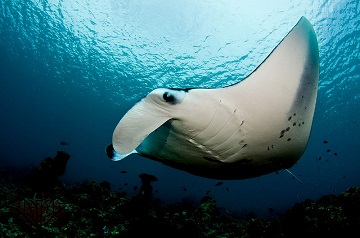340314-manta.JPG

Manta rays "fly" through the water. Credit: Shiyam ElkCloner, Creative Commons Attribution-Share Alike 3.0 Unported
If manta rays could pick a retirement home, it probably wouldn’t be Florida. Instead, they’d most likely select the islands of Indonesia, between Australia and Asia. In 2014, that country declared all of its waters — more than two million square miles — to be a manta-ray sanctuary. Capturing or killing the giant fish is banned, but swimming with them is encouraged. Manta rays “fly” through the water with giant fins that look like wings. They typically span 12 to 15 feet, although some rays are more than 20 feet wide and weigh more than a ton.
Manta rays are found in warm waters around the globe. But their numbers have been dwindling. One report says the global population has dropped by 30 percent in the last 75 years, with declines of more than 80 percent in some regions.
In Indonesia, they’ve been caught for the bony structures that protect their gills, which are a popular ingredient in folk medicine in China. The catch has amounted to about half-a-million dollars a year.
But manta-ray tourism brings in about 15 million dollars a year. The big creatures aren’t afraid of people, so they’ll swim and even play with divers, making them a popular attraction. So the math suggested that a live manta ray is worth a lot more than a dead one.
That doesn’t mean the rays are completely safe. It’s up to local governments to enforce the fishing ban, and they may not have the resources or the will to do so. Even so, the waters around Indonesia have gotten a lot friendlier for these gentle giants.

